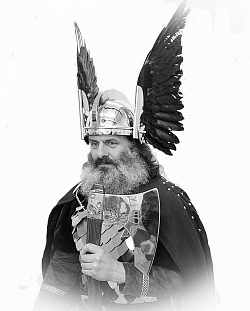Copyright © 2009 - 2025 Up Helly Aa Committee
Saga of Olav Haraldsson
Olav Haraldsson was born in Ringerike, Norway in AD 995, the son of Harald Grenske, a Viking King of Vestfold County, who died while Olav was still a young boy. Olav was of medium build but strong. He excelled in archery and spear throwing. He was a good swordsman and he hated to lose! He was good-looking, but when he turned angry his sharp blue eyes scared the other children. At the young age of 12 he was considered ready for life as a Viking warrior and was given his first command of a raiding party. He quickly distinguished himself as a leader and strategist, ably succeeding his father as head of the family.
Olav spent his early teens with his men raiding towns and villages along the coasts of the Baltic Sea as his father had done before him. His ‘mentor’ Rane taught him all the tricks of the trade, both at sea and on land. In Denmark Olav met Thorkell the Tall, a Danish Viking chief. They joined forces and decided to head west to England. For three years they raided south-east England.
In Snorre Sturlason’s sagas Olav is also said to have joined King Aethelred for a while in his fight against the Danes. He is noted for having helped Aethelred to take Southwark, which was key in Aethelred being accepted as King. The Danes had occupied London Bridge, preventing Aethelred’s progress. Olav directed his men to build ‘roofs’ over their longships to protect them from above. He then directed them to row up to the Bridge and tie ropes around the pillars, then when the tide was right to row as hard as they could downstream. The pillars gave way and the bridge came down. This is often thought to be the origin of the children’s nursery rhyme, London Bridge is Falling Down.
Following this, Olav offered his services to Duke Richard II of Normandy for a while and, whilst raiding in the Mediterranean, he had a dream in which a man came to him: “A man you would notice in a crowd,” Olav said. He was advised to return to Norway where he would become “King for all time.”
He returned to Normandy and spent the winter as Duke Richard’s guest, where he heard stories of King Carolus Magnus (Charlemagne) and how he had organised his empire. He also visited the cathedral where Richard and his men went to mass. He became convinced that Christianity was the right religion for himself and for Norway and was duly baptised in Rouen Cathedral.
Olav returned to Norway and set about building a strong following to help turn Norway into a single kingdom, by uniting the smaller kingdoms and using Christianity to bind them together. He succeeded and became King of all Norway in 1015.
Olav did not only make people accept Christianity, but he also made ‘Christian law’ the law of the land. All other laws had to be changed to fit the ‘Christian law’. This meant big changes in everyday life of all people and it soon became very unpopular among many, especially the chiefs and Jarls. The new laws reduced their position in society! They too now had to abide by it!
Olav had learned from his studies ofCharlmagne that he must always leave members of his own guard to ensure the obedience of the chiefs and Jarls in his absence. This ’enforcement’ only made things worse.
King Canute the Great, now ruler of Denmark and England, had turned his thoughts towards Norway and wanted to include this country in his empire.
Looking for allies in Norway, Canute started offering gifts to local chiefs around Norway. He also promised they would have their old privileges back if they accepted him as their king. They were only too pleased to accept. Olav tried in vain to prevent what was happening.
When King Canute himself arrived in 1028 with a large fleet, he was accepted as king everywhere, without having to fight a single battle. Olav had to flee from the country and went to Novgorod in Russia, to King Jaroslav, the husband of his wife’s half-sister. He stayed there for two years.
King Canute didn’t stay in Norway for long. He went back to England and left Hakon as Jarl of Norway, which was now part of his North Sea empire.
Hakon died in 1029 and, on hearing this. Olav prepared to return to retake Norway. He was met at Stiklestad by a huge army led by the local Jarls. It was here Olav met his death at the age of 35. His body was taken and buried near Trondheim. A year later, the body was exhumed by Bishop Grimkjell and found to be “sweet smelling, with hair and nails that had grown since the King died”. Encouraged by the people’s demands. Bishop Grimkjel canonised Olav and his body was brought into St Clement’s church where many miracles subsequently took place. Today St Olav’s day is still celebrated in Norway, on the 29th of July.
